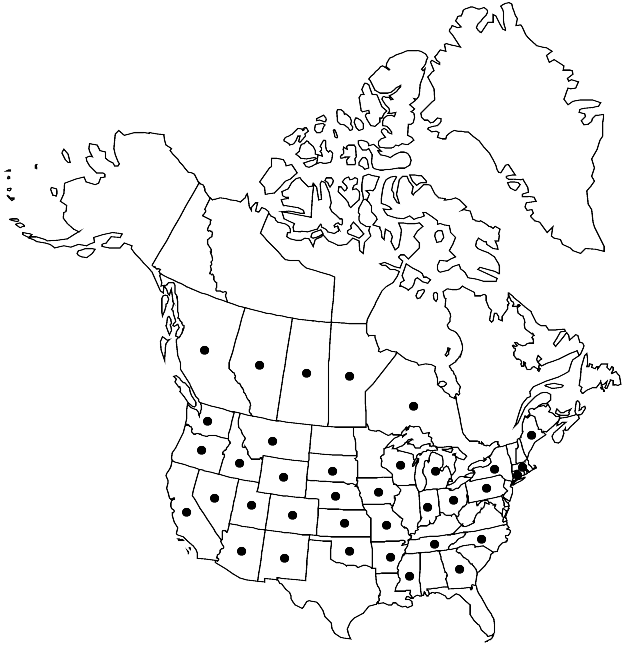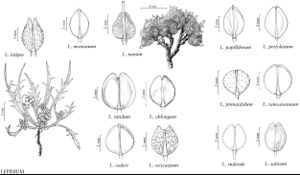Difference between revisions of "Lepidium perfoliatum"
Sp. Pl. 2: 643. 1753.
FNA>Volume Importer |
imported>Volume Importer |
||
| (One intermediate revision by the same user not shown) | |||
| Line 6: | Line 6: | ||
|place=2: 643. 1753 | |place=2: 643. 1753 | ||
|year=1753 | |year=1753 | ||
| + | }} | ||
| + | |special_status={{Treatment/ID/Special_status | ||
| + | |code=W | ||
| + | |label=Weedy | ||
| + | }}{{Treatment/ID/Special_status | ||
| + | |code=I | ||
| + | |label=Introduced | ||
| + | }}{{Treatment/ID/Special_status | ||
| + | |code=F | ||
| + | |label=Illustrated | ||
}} | }} | ||
|basionyms= | |basionyms= | ||
| Line 27: | Line 37: | ||
|elevation=0-2500 m | |elevation=0-2500 m | ||
|distribution=Alta.;B.C.;Man.;Ont.;Sask.;Ariz.;Ark.;Calif.;Colo.;Conn.;Ga.;Idaho;Ind.;Iowa;Kans.;Maine;Mass.;Mich.;Miss.;Mo.;Mont.;Nebr.;Nev.;N.Mex.;N.Y.;N.C.;Ohio;Okla.;Oreg.;Pa.;S.Dak.;Tenn.;Utah;Wash.;Wis.;Wyo.;Europe;Asia;n Africa;introduced also in Mexico (Baja California);South America (Argentina);Australia. | |distribution=Alta.;B.C.;Man.;Ont.;Sask.;Ariz.;Ark.;Calif.;Colo.;Conn.;Ga.;Idaho;Ind.;Iowa;Kans.;Maine;Mass.;Mich.;Miss.;Mo.;Mont.;Nebr.;Nev.;N.Mex.;N.Y.;N.C.;Ohio;Okla.;Oreg.;Pa.;S.Dak.;Tenn.;Utah;Wash.;Wis.;Wyo.;Europe;Asia;n Africa;introduced also in Mexico (Baja California);South America (Argentina);Australia. | ||
| + | |introduced=true | ||
|tables= | |tables= | ||
|references= | |references= | ||
| Line 49: | Line 60: | ||
|publication title=Sp. Pl. | |publication title=Sp. Pl. | ||
|publication year=1753 | |publication year=1753 | ||
| − | |special status= | + | |special status=Weedy;Introduced;Illustrated |
| − | |source xml=https:// | + | |source xml=https://bitbucket.org/aafc-mbb/fna-data-curation/src/2e0870ddd59836b60bcf96646a41e87ea5a5943a/coarse_grained_fna_xml/V7/V7_957.xml |
|tribe=Brassicaceae tribe Lepidieae | |tribe=Brassicaceae tribe Lepidieae | ||
|genus=Lepidium | |genus=Lepidium | ||
Latest revision as of 22:37, 5 November 2020
Annuals or biennials; (glaucous), glabrous or sparsely pubescent proximally. Stems simple from base, erect, branched distally, (0.7–)1.5–4.3(–5.6) dm. Basal leaves rosulate; petiole (0.5–)1–2(–4) cm; blade 2- or 3-pinnatifid or pinnatisect (lobes linear to oblong), (1–)3–8(–15) cm, margins entire. Cauline leaves sessile; blade ovate to cordate or suborbicular, (0.5–)1–3(–4) cm × (5–)10–25(–35) mm, base deeply cordate-amplexicaul, not auriculate, margins entire. Racemes considerably elongated in fruit; rachis glabrous. Fruiting pedicels divaricate-ascending to horizontal, straight, (terete), 3–6(–7) × 0.2–0.3 mm, glabrous. Flowers: sepals oblong, 0.8–1(–1.3) × 0.5–0.8 mm; petals pale yellow, narrowly spatulate, 1–1.5(–1.9) × 0.2–0.5 mm, claw 0.5–1 mm; stamens 6; filaments 0.6–0.9 mm, (glabrous); anthers 0.1–0.2 mm. Fruits orbicular to rhombic or broadly obovate, 3–4.5(–5) × 3–4.1 mm, apically winged, apical notch 0.1–0.3 mm deep; valves thin, smooth, not or obscurely veined, glabrous; style 0.1–0.4 mm, subequaling or slightly exserted beyond apical notch. Seeds (dark brown), ovate, 1.6–2(–2.3) × 1.2–1.4 mm. 2n = 16.
Phenology: Flowering Mar–Jun.
Habitat: Waste places, dry sandy slopes, pinyon-juniper woodlands, sagebrush flats, open deserts, roadsides, pastures, meadows, open grasslands, alkaline flats and sinks, fields, disturbed sites
Elevation: 0-2500 m
Distribution

Introduced; Alta., B.C., Man., Ont., Sask., Ariz., Ark., Calif., Colo., Conn., Ga., Idaho, Ind., Iowa, Kans., Maine, Mass., Mich., Miss., Mo., Mont., Nebr., Nev., N.Mex., N.Y., N.C., Ohio, Okla., Oreg., Pa., S.Dak., Tenn., Utah, Wash., Wis., Wyo., Europe, Asia, n Africa, introduced also in Mexico (Baja California), South America (Argentina), Australia.
Discussion
Selected References
None.
